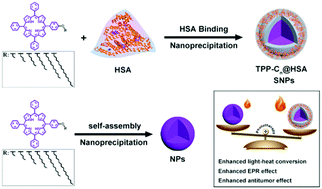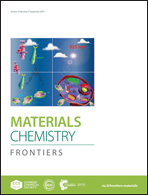Stable supramolecular porphyrin@albumin nanoparticles for optimal photothermal activity†
Abstract
Porphyrins and their derivatives have been widely exerted as potential phototherapeutic nanomaterials in biomedical fields because of their favorable biocompatibility as well as easy chemical modification. However, the intrinsic hydrophobic properties still limit their further clinical translation. Albumin has been developed as a promising carrier for chemotherapeutic and protein drugs. Except for enhanced water solubility, using human serum albumin (HSA) endows efficient cellular internalization, prolonged blood circulation time, intensive tissue penetration depth and favorable pharmacokinetics and biodistribution. Herein, we constructed supramolecular nanoparticles (HSA–porphyrin SNPs) by the rational assembly of hexadecyl chain bonded porphyrin with HSA in a 1 : 1 stoichiometry via a tight non-covalent interaction. The as-prepared SNPs exhibited robust photostability, a high photothermal conversion efficiency of 45% and recycled utilization. The SNPs can be endocytosed effectively, thus eliciting superb cancer cell inhibition in vitro and thermal ablation of tumors in vivo under illumination. We believe that this study can offer a new horizon to understand the interaction of small molecules with HSA, which highlights the opportunity to explore the next-generation HSA-binding nanomedicine for future cancer precision therapy.



 Please wait while we load your content...
Please wait while we load your content...